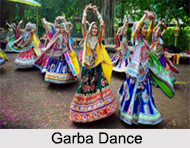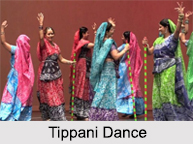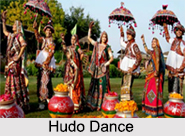 Folk dances of Gujarat are the identity of the typical Gujarati culture and tradition. The vibrant, colourful and energetic Gujarati folk dances truly reflect the essence of the society. Gujarat is identified by its rich preserved tradition of songs, dances and dramas. The Gujarati folk have a natural talent for singing and dancing. The best known among these is the Garba and Dandiya. Folk drama in Gujarat is known as Bhavai dance. Most of the art traditions trace back their origin to the ancient period.
Folk dances of Gujarat are the identity of the typical Gujarati culture and tradition. The vibrant, colourful and energetic Gujarati folk dances truly reflect the essence of the society. Gujarat is identified by its rich preserved tradition of songs, dances and dramas. The Gujarati folk have a natural talent for singing and dancing. The best known among these is the Garba and Dandiya. Folk drama in Gujarat is known as Bhavai dance. Most of the art traditions trace back their origin to the ancient period.
Garba
Garba is a popular folk dance of Gujarat and is famous in all parts of India. This dance is performed by the womenfolk of Gujarat and has connection with Shakti-Puja and its origin is believed to be in the worship of goddess Jagdamba. At the time of Navaratri, this dance is performed throughout nine nights. This folk dance is performed also on occasions such as Sharad Purnima, Vasant Panchami and Holi and is presented by the ladies in a circular form. Usually kedia and churidar are worn during the performance and the instruments of this dance form include damru, tabla, nagara, murli, turi, shehnai etc. Other than this, there is another form of Garba known as Garbi which is primarily performed by men during religious festivals like Janmashtami.
Dandiya
Known to be one of the most popular folk dances in Gujarat, the dance form of Dandiya is also known as the stick dance. This dance form is always performed in a group in a circular movement to a measure steps. The sticks used in this form are believed to be the sword of Goddess Durga. This is another form of dance that is also a feature of most welcomed festival, Navaratri. The main difference between the Garba and Dandiya dance performances is that Garba is performed before Aarti while Dandiya Ras is performed after it. Garba is performed exclusively by women but in Dandiya both men and women can join in. It is mainly performed by the women in a graceful and rhythmic manner but men also join it when it is performed in pairs. They generally wear traditional Gujarati dress like flashy ghagras, choli, bandhani dupattas paired with silver jewellery.
Bhavai
The Bhavai Dance is believed to be dance of emotions and is a typical folk drama of Gujarat. In this form of folk dance, the male and female dancers balance up to 7 to 9 brass pitchers on their head as they dance nimbly, pirouetting and then swaying with the soles of their feet perched on the top of a glass or on the edge of the sword. The Bhavai drama is a continuous performance lasting the whole night and staged in open grounds before the audiences, as a source of entertainment.
 Tippani
Tippani
Performed exclusively by women, Tippani is a popular folk dance in Gujarat which originated from the Chorwad district. It is common among the Koli and Kharva people of the coastal region and is performed while beating the floor in two opposite rows accompanied by folk songs. With simple musical instruments like a Thali and a Turi, dancers produce the music. The dance originated among labourers but is now performed on festivals and wedding. The folk costumes are also traditional and typical consisting of a short coat called kedia and tight trousers or churidars, colourfully embroidered caps, turbans and waist-band.
 Padhar
Padhar
Performed by the people of Padhar community, the Padhar dance is another of the prominent folk dances in Gujarat. The people of the Padhar community are mainly fishermen who live along the banks of Nal Sarovar of Bhal region. They are the followers of Hinduism and worship Goddess Durga in various forms. While performing this dance, the dancer replicates the events that happen in the life of mariners. Rising and falling of sea waves and the wandering nature of mariner"s job is shown through this dance form. The performer holds small sticks in their hands while dancing and enacts the rowing of boats while singing songs associated with water.
Hudo
Another popular folk dance of Gujarat, Hudo is a dance form of the Bharwad Tribe, the shepherd community of Gujarat. The idea of the dance originated from sheep fights. The movements of two sheeps ramming their heads are duplicated in this dance form. The dancers clap their hands in a forceful and rhythmic manner while the traditional musical instruments of dholak, harmonium, flute, kansi, joda and manjira are used as accompaniments. Popular among the Panchal region of Gujarat, the beauty of the dance lies within the gorgeous costumes worn by the dancers. One interesting part of the costume is the presence of an umbrella with beautiful embroidered pattern and the fine lace and mirror work is simply stunning.
 Gujarat is known to be the Land of Festivals and celebrates a large number of festivals every year. These celebrations are accompanied with musical performances and traditional dance forms based on their rich culture and heritage. Thus, the folk dances of Gujarat are not only practised in the western state but are also quite popular all over the nation.
Gujarat is known to be the Land of Festivals and celebrates a large number of festivals every year. These celebrations are accompanied with musical performances and traditional dance forms based on their rich culture and heritage. Thus, the folk dances of Gujarat are not only practised in the western state but are also quite popular all over the nation.



















